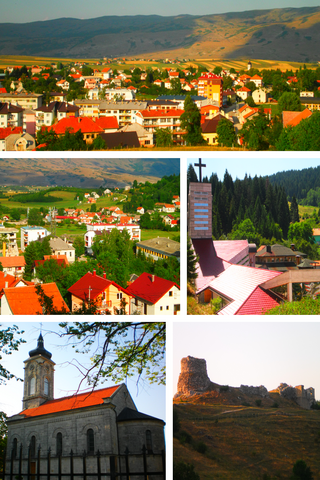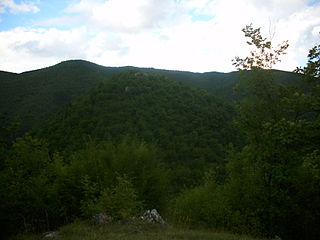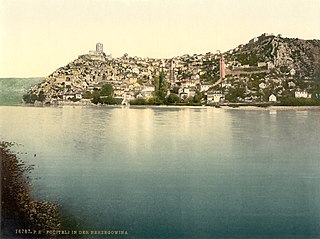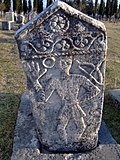
Jajce is a town and municipality in the Central Bosnia Canton of the Federation of Bosnia and Herzegovina, an entity of Bosnia and Herzegovina. According to the 2013 census, the town has a population of 7,172 inhabitants, with 27,258 inhabitants in the municipality, It is situated in the region of Bosanska Krajina, on the crossroads between Banja Luka, Mrkonjić Grad and Donji Vakuf, on the confluence of the rivers Pliva and Vrbas.

Travnik is a town and a municipality in Bosnia and Herzegovina. It is the administrative center of the Central Bosnia Canton of the Federation of Bosnia and Herzegovina. It is situated in central Bosnia and Herzegovina, 90 kilometres west of Sarajevo. As of 2013, the town had a population of 15,344 inhabitants, while the municipality had 53,482 inhabitants.

Visoko is a city located in the Zenica-Doboj Canton of the Federation of Bosnia and Herzegovina, an entity of Bosnia and Herzegovina. As of 2013, the municipality had a population of 39,938 inhabitants with 11,205 living in Visoko town. Located between Zenica and Sarajevo, Visoko lies where the river Fojnica joins the Bosna.

Tešanj is a town and municipality located in the Zenica-Doboj Canton of the Federation of Bosnia and Herzegovina, an entity of Bosnia and Herzegovina. As of 2013, the municipality has a population of 43,063 inhabitants, while the town of Tešanj has a population of 5,257 inhabitants. It is situated in the northern part of Bosnia and Herzegovina.

Kreševo is a town and municipality located in Central Bosnia Canton of the Federation of Bosnia and Herzegovina, an entity of Bosnia and Herzegovina. Kreševo is a mountainous town, located in a narrow valley of the Kreševka river, under the slopes of Mount Bitovnje. An old Franciscan monastery of St. Catharine is located in the town's outskirts.

Glamoč is a town and the seat of the Municipality of Glamoč in Canton 10 of the Federation of Bosnia and Herzegovina, an entity of Bosnia and Herzegovina. It is situated in southwestern Bosnia and Herzegovina, at the foothills of Staretina and Velika Golija mountains, and on the edge of the central part of the Glamočko Polje.

Tourism in Bosnia and Herzegovina is a fast-growing sector making up an important part in the economy of the country.

Počitelj is a settlement and a historic village in the town of Čapljina in Bosnia and Herzegovina. Its walled nucleus is protected National Monument of Bosnia and Herzegovina and an open-air museum. The settlement is situated on the left bank of the river Neretva, on the main road Mostar-Metković.

The Lašva Valley is a 17 kilometers long valley in central Bosnia, defined geographically by the Lašva River's route. It is a tributary of the Bosna River. The Lašva River basin covers the territory of four municipalities: Travnik, Novi Travnik, Vitez and Busovača.

Srebrenik Fortress is a fortress located near the city of Srebrenik in Bosnia and Herzegovina. It has been a national monument of Bosnia and Herzegovina since 2 November 2004.

The Walled City of Jajce is a medieval fortified nucleus of Jajce in Bosnia and Herzegovina, with Jajce Citadel high above town on top of pyramidal-shaped steep hill, enclosed with approximately 1,300 metres (4,300 ft) long defensive walls,. It is one of the best preserved fortified capitals of the Bosnian Kingdom, the last stronghold before the kingdom dissolved under the pressure of military advancement at the onset of Ottoman Empire takeover.

The siege of Jajce was a siege of the town of Jajce and its citadel in 1463, in a push by Ottomans to conquer as much of the Bosnian Kingdom, and continuation of the Ottoman–Hungarian Wars. After the fall of Travnik and royal fortress of Bobovac, in the initial days of invasion, Ottomans, led by Sultan captured the town. One of the parties pursued Bosnian King Stjepan Tomašević, and caught up with him at Ključ fortress, after which he was brought to Jajce and executed. Soon the Ottomans forces withdraw, leaving the town under the protection of a small garrison. The Hungarian took the opportunity to capture the citadel, and this meant that Ottoman advancement in Bosnia was halted for the time being. The northern part of Bosnia were brought under Hungarian control, and divided into three administrative regions, Banate of Jajce, Banate of Srebrenik, established around Srebrenik fortress, and a puppet statelet named "Bosnian Kingdom". This situation and Jajce under Hungarian garrison will last until 1527 when the Ottomans finally took the town, and breaking the lines advanced northward to Hungary and westward to Bihać, which was part of the Kingdom of Croatia.

The Ostrovica Castle is a large medieval structure situated above the small village of Ostrovica near Kulen Vakuf, Bihać municipality, Bosnia and Herzegovina. Having been built on a heavily wooded ridge of a steep hill overlooking left bank of the shallow Una river, the castle was located on a strategic site connecting the northern and southern parts of the long Una valley.

Vratnik, also known as Stari grad Vratnik, is one of the oldest neighbourhoods in Sarajevo, Bosnia and Herzegovina.
The siege of Jajce took place between 10 July and 22 August 1464, during the Ottoman conquest of Bosnia and Herzegovina, when an Ottoman army under Sultan Mehmed II made a new attempt to conquer Bosnia and take control of the strategic fortress of Jajce, south of Banja Luka, at the time under Hungarian control.

The Walled city of Vratnik, also Old Vratnik Fort, is located in Vratnik neighborhood, in Sarajevo, Bosnia and Herzegovina. It represents urban core within the wider neighbourhood of the same name. Since 2005 the KONS designated walled area of the neighborhood a national monument of Bosnia and Herzegovina.

Ključ fortrass, locally known as Stari grad Ključ, is a medieval castle complex in the village of Ključ, Gacko, Bosnia and Herzegovina. The historic area includes the Ključ fortress, the Podključ castle town as part of a wider area just beneath of the fortress, the Ključ Mosque with a harem. The site has been declared a National monument of Bosnia and Herzegovina by the Commission to preserve national monuments of Bosnia and Herzegovina.

Sokograd, also known as Pliva or Plivski grad, Pliva-Soko, Sokol-grad, Soko-grad, or simply Soko or Sokol, is a medieval fortress with a castle town in the Pliva river valley, between Gerzovo and nearby Šipovo, in Šipovo municipality, Republika Srpska entity of Bosnia and Herzegovina. It was a very important fortress for the medieval Bosnian state, and the center of the župa Pliva. It was built in a canyon on a steep slope high above the river Sokočnica, which flows into Pliva in Šipovo.

Ključ Fortress is a medieval fortress in Bosnia and Herzegovina, above the modern-day town of Ključ. It is located on an elongated slope on high rocks that dominate the valley of the river Sana. Before it was redeveloped, there was a small ancient fortress from Roman times.

Walled town of Počitelj is a medieval fortified nucleus of Počitelj historic village, in the municipality of Čapljina, Bosnia and Herzegovina. Due to its significant architectural and urbanistic historical value, it is considered an open-air museum. The Walled town is nested in a natural karst amphitheater along the left bank of the Neretva river, on the main road Mostar-Metković. The walled nucleus is protected as a National Monument of Bosnia and Herzegovina. The architectural ensemble of Počitelj is also proposed as such for inscription into the UNESCO's list of World Heritage Sites. The bid for inscription is currently placed on the UNESCO Tentative list.























